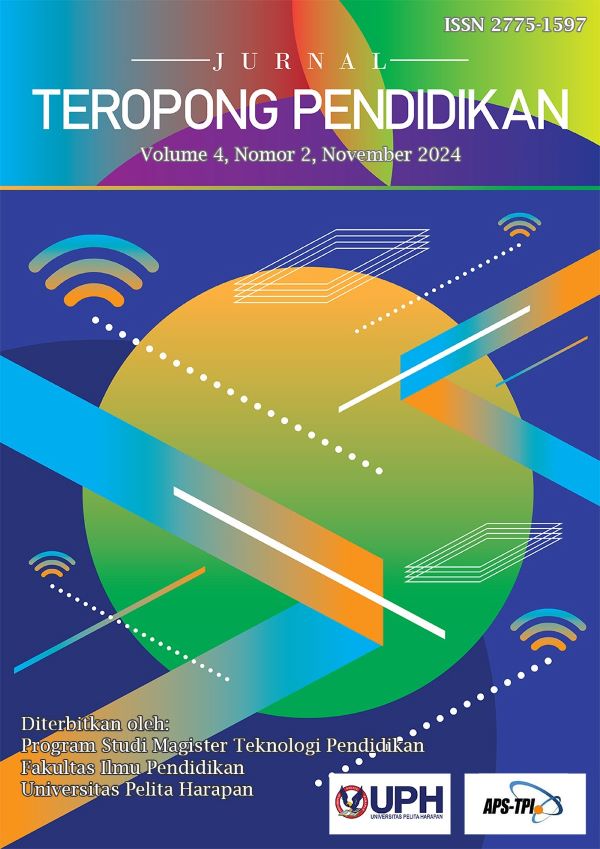Pengukuran Keterampilan Komunikasi Siswa Setelah Pandemi Covid 19 [Measuring Students' Communication Skills After the Covid-19 Pandemic]
DOI:
https://doi.org/10.19166/jtp.v4i2.7725Keywords:
Communication, SkillsAbstract
Communication skills are essential for everyone, including students. The COVID-19 pandemic had a significant impact on the education sector, with learning heavily relying on students' ability to use information technology. During this period, communication and interaction depended on the quality of the hardware used and the stability of internet connections. Due to unprecedented restrictions, these limitations affected students' communication skills, both written and verbal. There have been assumptions and speculations from teachers and parents that students' communication skills have declined after the pandemic. This study aims to understand how well students have developed their communication skills post-pandemic. Research employs a quantitative research method. Data was collected by distributing open-ended questionnaires to 6th-grade students at XYZ Elementary School. A total of 45 students participated in the study. The results of this study indicate that the average communication skills of the students at XYZ Elementary School in Tangerang after the pandemic are considered adequate. Therefore, teachers need to focus on improving students' communication skills to enhance them further.
References
Abdurrohim, M., & Budiono, H. (2020). Peran guru dalam mengembangkan keterampilan komunikasi. Jurnal IKA PGSD, 8(1), 119–127. https://doi.org/10.36841/pgsdunars.v8i1.589
Asmiati, L., Pratiwi, I. A., & Fardhani, M. A. (2021). Dampak penggunaan game online terhadap kemampuan berkomunikasi anak. Jurnal Ilmiah P2M STKIP, 8(1), 37–45. https://doi.org/10.22460/p2m.v8i1p37-45.2227
Aswata. (2020). Mulai diterapkan di Indonesia, apa itu PSBB dan apa fungsinya?. Aswata. https://www.aswata.co.id/id/berita/info-tips/517-mulai-diterapkan-di-indonesia-apa-itu-psbb-dan-apa-fungsinya
Handayani, S., Masfuah, S., & Kironoratri, L. (2021). Analisis kemampuan komunikasi siswa dalam pembelajaran daring siswa sekolah dasar. Edukatif, 3(5), 2240–2246. https://doi.org/10.31004/edukatif.v3i5.770
Laudhira, H. K., & Sukartono, S. (2022). Penerapan media pembelajaran berbasis TIK pada pembelajaran tematik di sekolah dasar. Jurnal Basicedu, 6(4), 5501–7663. https://doi.org/10.31004/basicedu.v6i4.3269
Mulyana, D. (2010). Ilmu komunikasi, suatu pengantar. PT. Remaja Rosda Karya.
Nofrion. (2016). Komunikasi pendidikan, penerapan teori dan konsep komunikasi dalam pembelajaran. Kencana.
Rohan, A. (2020, September 8). How has Covid-19 affected the way we communicate?. UAB. https://www.uab.edu/news/research/item/11542-how-has-covid-19-affected-the-way-we-communicate
Susanto, E. H. (2010). Komunikasi esensi dan aplikasi dalam dinamika sosial ekonomi politik. Mitra Wacana Media.
Uchjana, U., & Onong, E. (2015). Dinamika komunikasi (1st ed.). PT. Remaja Rosda Karya.
Downloads
Published
Issue
Section
License
Copyright (c) 2025 Patricius Dwi Krisdianto; Wahyu Widjaya; Ni Putu Hindriani Christianingsih; Rizki Raindriati

This work is licensed under a Creative Commons Attribution-ShareAlike 4.0 International License.
Authors who publish with this journal agree to the following terms:
1) Authors retain copyright and grant the journal right of first publication with the work simultaneously licensed under a Creative Commons Attribution License (CC-BY-SA 4.0) that allows others to share the work with an acknowledgement of the work's authorship and initial publication in this journal.
2) Authors are able to enter into separate, additional contractual arrangements for the non-exclusive distribution of the journal's published version of the work (e.g., post it to an institutional repository or publish it in a book), with an acknowledgement of its initial publication in this journal.
3) Authors are permitted and encouraged to post their work online (e.g., in institutional repositories or on their website). The final published PDF should be used and bibliographic details that credit the publication in this journal should be included.





